香港西九龙国际竞赛方案OMA、Foster+Parteners+Rocco Design Architects West Kowloon Cultural District
- 格式:pdf
- 大小:4.40 MB
- 文档页数:37

一、规划三剑客西九文化区概念规划方案香港西九文化区的建设项目恐怕是当今世界上规模最大,最雄心勃勃,也是一直富于争议性的文化建设项目。
8月20日,备受关注的文化区三个规划方案终于出台了!三家规划设计顾问公司——英国的Foster + Partners(以下简称福斯特),香港的许李严建筑师事务有限公司(以下简称许李严或严讯奇)和荷兰的OMA(以下称OMA或库哈斯),各自领取酬金约4,900万港元,经过一年的闭门铸造,终于向香港公众亮出自己的绝招。
三个概念规划方案自8月21日起在香港会展中心等地展出,进行为期三个月的公众咨询,收集市民意见,最后西九文化区管理局将“综合各方意见”选取一个主导方案。
“西九兴亡,匹夫有责”。
我去仔细看了展览,研读了各设计公司提供的资料,产生一些个人看法,想提出来,与大家交换意见。
在直接讲我个人看法前,我认为有必要先分析一下基地的现状——这是我评判各方案的出发点。
西九头顶几大怪我们香港城市有诸多特色,其中包含两大精髓:便利的公共交通和生机勃勃的街道文化。
前者体现为发达的地铁、公交、电车、航船线路以及相互间便捷的接驳;后者体现为密集的街道网络、频繁出现的街道交叉口、小尺度的街区划分、沿街多样的小商业设施、以及——很重要的——似乎永远都不缺的人气——步行人流。
有时走在铜锣湾、旺角的街道,我也会觉得有点太过拥挤。
也许人口密度稍低点,街道稍宽些会让人更感舒适。
但这只是个度的调整问题,香港街道文化的本质构成总的说来是值得我们珍惜的。
总之,便利的交通加上街道文化这两大精髓,结合其它特征,形成的良好城市空间格局在港岛、九龙比比皆是。
但是,西九文化区周边的城市环境现状如何?相信去过的人大多会同意我,也有两大特点,与香港的城市精髓恰恰相反:极差的公共交通通达性和极端反人性的步行环境!与紧靠东边的尖沙咀和油麻地两个片区的小尺度街区划分、密集的街道网络、方便步行的街区环境、热闹非凡的街道生活相比,西九片区简直就是城市生活的死角和荒漠。
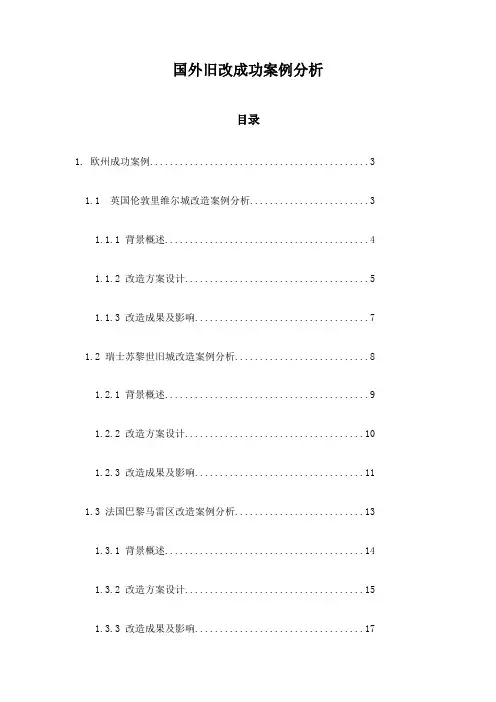
国外旧改成功案例分析目录1. 欧州成功案例 (3)1.1 英国伦敦里维尔城改造案例分析 (3)1.1.1 背景概述 (4)1.1.2 改造方案设计 (5)1.1.3 改造成果及影响 (7)1.2 瑞士苏黎世旧城改造案例分析 (8)1.2.1 背景概述 (9)1.2.2 改造方案设计 (10)1.2.3 改造成果及影响 (11)1.3 法国巴黎马雷区改造案例分析 (13)1.3.1 背景概述 (14)1.3.2 改造方案设计 (15)1.3.3 改造成果及影响 (17)2. 美洲成功案例 (18)2.1 美国纽约下城酒吧街改造案例分析 (19)2.1.1 背景概述 (21)2.1.2 改造方案设计 (21)2.1.3 改造成果及影响 (23)2.2 巴西里约热内卢老城改造案例分析 (24)2.2.1 背景概述 (26)2.2.2 改造方案设计 (27)2.2.3 改造成果及影响 (28)2.3 墨西哥墨西哥城历史城中心改造案例分析 (29)2.3.1 背景概述 (30)2.3.2 改造方案设计 (32)2.3.3 改造成果及影响 (33)3. 亚洲成功案例 (34)3.1 韩国首尔兴京地区改造案例分析 (36)3.1.1 背景概述 (38)3.1.2 改造方案设计 (39)3.1.3 改造成果及影响 (40)3.2 新加坡莱佛士初创区改造案例分析 (41)3.2.1 背景概述 (43)3.2.2 改造方案设计 (44)3.2.3 改造成果及影响 (45)3.3 日本东京神田地区改造案例分析 (46)3.3.1 背景概述 (48)3.3.2 改造方案设计 (49)3.3.3 改造成果及影响 (50)4. 总结与展望 (52)4.1 国外旧改成功经验总结 (53)4.2 对中国旧改的启示 (54)4.3 未来发展展望 (55)1. 欧州成功案例汉堡市位于德国北部,是德国第二大城市和最重要的海港和最大的外贸中心、德国第二金融中心,同时是德国北部的经济和文化大都市,有着“世界桥城”的美称。
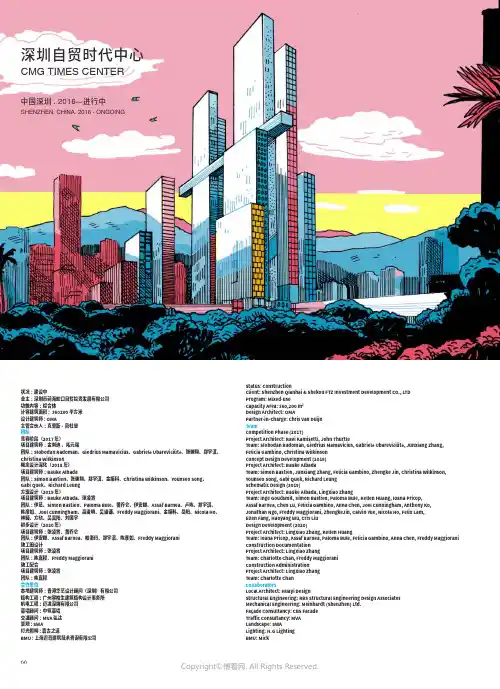
CMG TIMES CENTER 深圳自贸时代中心中国深圳. 2016—进行中SHENZHEN, CHINA. 2016 - ONGOING状况:建设中业主:深圳市前海蛇口自贸投资发展有限公司功能内容:综合体计容建筑面积: 360200平方米设计建筑师: OMA主管合伙人:克里斯· 范杜恩团队竞赛阶段(2017 年)项目建筑师:金刹迪 、拓元强团队:Slobodan Radoman、Giedrius Mamavicius、Gabrielė Ubarevičiūtė、张骏翔、郑宇淇、Christina Wilkinson概念设计深化(2018 年)项目建筑师:Bauke Albada团队:Simon Bastien、张骏翔、郑宇淇、金振科、Christina Wilkinson、Younseo Song、Gabi Quek、Richard Leung方案设计(2019 年)项目建筑师:Bauke Albada、张凌霄团队:伊葛、Simon Bastien、Paloma Bule、黄乔仑、伊安娜、Assaf Barnea、卢陈、郑宇淇、陈彦如、Joel Cunningham、高浚明、吴诵谦、Freddy Maggiorani、金振科、岳阳、Nicola Ho、林臻、方晓、吴昊阳、刘国宇初步设计(2020 年)项目建筑师:张凌霄、黄乔仑团队:伊安娜、Assaf Barnea、帕洛玛、郑宇淇、陈彦如、Freddy Maggiorani施工图设计项目建筑师:张凌霄团队:陈嘉程、Freddy Maggiorani施工配合项目建筑师:张凌霄团队:陈嘉程合作单位本地建筑师:香港华艺设计顾问(深圳)有限公司结构工程:广州容柏生建筑结构设计事务所机电工程:迈进深圳有限公司幕墙顾问:中筑幕墙交通顾问:MVA 弘达景观: SWA灯光照明: 寰古之道BMU : 上海迈苛建筑技术咨询有限公司Status: ConstructionClient: Shenzhen Qianhai & Shekou FTZ Investment Development CO., L TD Program: Mixed-useCapacity Area: 360,200 m2Design Architect: OMAPartner-in-Charge: Chris van DuijnTeamCompetition Phase (2017)Project Architect: Ravi Kamisetti, John ThurtleTeam: Slobodan Radoman, Giedrius Mamavicius, Gabrielė Ubarevičiūtė, Junxiang Zhang, Felicia Gambino, Christina WilkinsonConcept Design Development (2018)Project Architect: Bauke AlbadaTeam: Simon Bastien, Junxiang Zhang, Felicia Gambino, Zhengke Jin, Christina Wilkinson, Younseo Song, Gabi Quek, Richard LeungSchematic Design (2019)Project Architect: Bauke Albada, Lingxiao ZhangTeam: Inge Goudsmit, Simon Bastien, Paloma Bule, Kellen Huang, Ioana Pricop,Assaf Barnea, Chen Lu, Felicia Gambino, Anna Chen, Joel Cunningham, Anthony Ko, Jonathan Ngo, Freddy Maggiorani, ZhengkeJin, Calvin Yue, Nicola Ho, Felix Lam,Ellen Fang, Haoyang Wu, Cris LiuDesign Development (2020)Project Architect: Lingxiao Zhang, Kellen HuangTeam: Ioana Pricop, Assaf Barnea, Paloma Bule, Felicia Gambino, Anna Chen, Freddy Maggiorani Construction DocumentationProject Architect: Lingxiao ZhangTeam: Charlotte Chan, Freddy MaggioraniConstruction AdministrationProject Architect: Lingxiao ZhangTeam: Charlotte ChanCollaboratorsLocal Architect: Huayi DesignStructural Engineering: RBS Structural Engineering Design Associates Mechanical Engineering: Meinhardt (Shenzhen) Ltd.Façade Consultancy: CBS FacadeTraffic Consultancy: MVALandscape: SWALighting: H.G LightingBMU: Mick形体生成 Massing Evolution项目位于妈湾片区的核心位置,衔接了区域内各个功能板块与交通基础设施,同时紧邻东侧的大型公共景观空间。
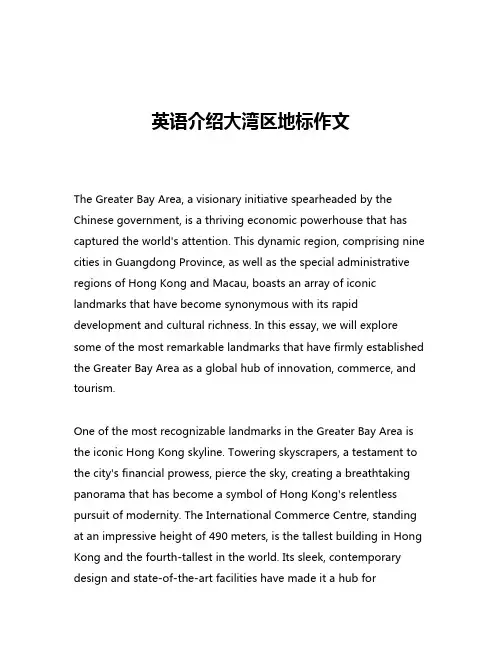
英语介绍大湾区地标作文The Greater Bay Area, a visionary initiative spearheaded by the Chinese government, is a thriving economic powerhouse that has captured the world's attention. This dynamic region, comprising nine cities in Guangdong Province, as well as the special administrative regions of Hong Kong and Macau, boasts an array of iconic landmarks that have become synonymous with its rapid development and cultural richness. In this essay, we will explore some of the most remarkable landmarks that have firmly established the Greater Bay Area as a global hub of innovation, commerce, and tourism.One of the most recognizable landmarks in the Greater Bay Area is the iconic Hong Kong skyline. Towering skyscrapers, a testament to the city's financial prowess, pierce the sky, creating a breathtaking panorama that has become a symbol of Hong Kong's relentless pursuit of modernity. The International Commerce Centre, standing at an impressive height of 490 meters, is the tallest building in Hong Kong and the fourth-tallest in the world. Its sleek, contemporary design and state-of-the-art facilities have made it a hub formultinational corporations and a must-visit destination for tourists seeking to experience the city's dynamic energy.Another architectural marvel that has captured the imagination of visitors to the Greater Bay Area is the Guangzhou Opera House, designed by the renowned architect Zaha Hadid. This stunning structure, with its fluid, organic form, has become an iconic landmark in the city of Guangzhou. The opera house's striking design, which has been likened to a pebble smoothed by the flow of water, not only serves as a world-class performing arts venue but also stands as a testament to the region's commitment to fostering cultural excellence and innovation.The Shenzhen Bay Bridge, connecting the cities of Shenzhen and Hong Kong, is another engineering marvel that has become a symbol of the Greater Bay Area's connectivity. Stretching over 5.5 kilometers, the bridge is a testament to the region's commitment to seamless transportation and infrastructure development. The bridge's elegant design, featuring a unique cable-stayed structure, has made it a popular destination for tourists and locals alike, who flock to the area to admire the stunning views of the surrounding landscape.The Guangzhou Tower, standing at a height of 604 meters, is the tallest building in the Greater Bay Area and the second-tallest inChina. This iconic structure, with its distinctive twisted design, has become a landmark that is instantly recognizable throughout the region. The tower's observation deck, which offers panoramic views of the city, has become a popular attraction for visitors seeking to experience the breathtaking vistas of the Greater Bay Area.The Macau Tower, standing at a height of 338 meters, is another iconic landmark that has become synonymous with the Greater Bay Area. This striking structure, designed by the renowned architect Paul Andreu, is known for its unique architectural style, which has been likened to a giant golf tee. The tower's observation deck, which offers stunning views of the Macau Peninsula and the surrounding islands, has become a popular destination for thrill-seekers, who can enjoy activities such as bungee jumping and skywalk experiences.The Guangzhou Baiyun International Airport, one of the busiest airports in the world, is another landmark that has become integral to the Greater Bay Area's identity. This state-of-the-art facility, which features a sleek, modern design and advanced technological infrastructure, has become a hub for international travel and a gateway to the region. The airport's expansive terminal buildings, seamless passenger flow, and efficient operations have made it a model for airport design and management, attracting visitors from around the world.The Greater Bay Area's commitment to sustainability and environmental preservation is exemplified by the Guangzhou Evergrande Football Stadium, a cutting-edge sports facility that has been designed with a focus on eco-friendly features. The stadium's unique, undulating roof structure, which is covered in solar panels, generates renewable energy to power the facility, making it a symbol of the region's dedication to sustainable development.These landmarks, each with its own distinct character and significance, have not only become iconic symbols of the Greater Bay Area but have also played a crucial role in shaping the region's identity and driving its continued growth and development. As the Greater Bay Area continues to evolve and expand, these landmarks will undoubtedly remain at the forefront, serving as beacons of innovation, cultural excellence, and sustainable progress.。
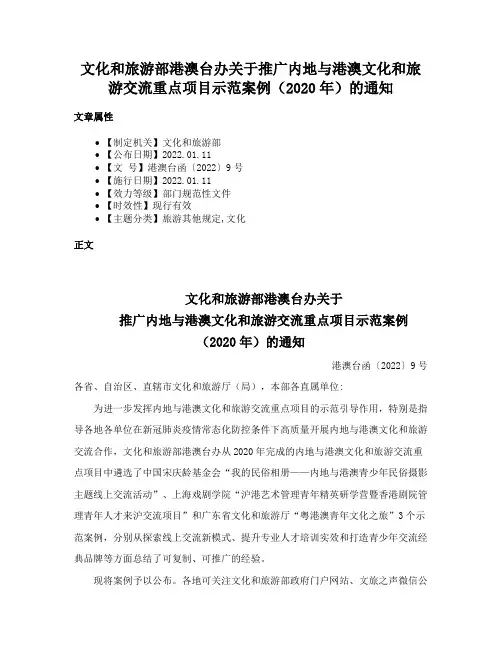
文化和旅游部港澳台办关于推广内地与港澳文化和旅游交流重点项目示范案例(2020年)的通知
文章属性
•【制定机关】文化和旅游部
•【公布日期】2022.01.11
•【文号】港澳台函〔2022〕9号
•【施行日期】2022.01.11
•【效力等级】部门规范性文件
•【时效性】现行有效
•【主题分类】旅游其他规定,文化
正文
文化和旅游部港澳台办关于
推广内地与港澳文化和旅游交流重点项目示范案例
(2020年)的通知
港澳台函〔2022〕9号各省、自治区、直辖市文化和旅游厅(局),本部各直属单位:
为进一步发挥内地与港澳文化和旅游交流重点项目的示范引导作用,特别是指导各地各单位在新冠肺炎疫情常态化防控条件下高质量开展内地与港澳文化和旅游交流合作,文化和旅游部港澳台办从2020年完成的内地与港澳文化和旅游交流重点项目中遴选了中国宋庆龄基金会“我的民俗相册——内地与港澳青少年民俗摄影主题线上交流活动”、上海戏剧学院“沪港艺术管理青年精英研学营暨香港剧院管理青年人才来沪交流项目”和广东省文化和旅游厅“粤港澳青年文化之旅”3个示范案例,分别从探索线上交流新模式、提升专业人才培训实效和打造青少年交流经典品牌等方面总结了可复制、可推广的经验。
现将案例予以公布。
各地可关注文化和旅游部政府门户网站、文旅之声微信公
众号、《中国旅游报》及有关新闻媒体对示范案例进行的展示报道,结合实际在开展对港澳文化和旅游交流中借鉴参考。
特此通知。
文化和旅游部港澳台办
2022年1月11日。

韶关市人民政府办公室印发韶关市第九届中小学生“英东杯”文体竞赛方案的通知文章属性•【制定机关】韶关市人民政府•【公布日期】2004.06.14•【字号】韶府办[2004]76号•【施行日期】2004.06.14•【效力等级】地方规范性文件•【时效性】现行有效•【主题分类】体育正文韶关市人民政府办公室印发韶关市第九届中小学生“英东杯”文体竞赛方案的通知(韶府办〔2004〕76号)各县、市、区人民政府,市府直属有关单位:为发展我市文化教育事业,提高青少年文化体育活动兴趣,全面推进素质教育,根据霍英东基金会建议,经市政府同意,我市定于今年下半年举办第九届“英东杯”文体竞赛活动。
现将《韶关市第九届中小学生“英东杯”文体竞赛方案》印发给你们,请按照落实。
附:韶关市第九届中小学生“英东杯”文体竞赛方案韶关市人民政府办公室二○○四年六月十四日韶关市第九届中小学生“英东杯”文体竞赛方案一、主办单位:由霍英东基金会、韶关市教育局、韶关市体育局、韶关市文化局、《韶关上报》社、韶关电视台、韶关人民广播电台联合主办。
二、组织实施(一)成立竞赛组织委员会,负责本次竞赛的组织领导,名单如下:总顾问:霍英东(博士霍英东基金会主席)顾问:徐建华(韶关市市长)何铭思(霍英东基金会顾问、铭源基金主席)韦丘(著名诗人原广东作协副主席)主任:丘隆基(韶关市副市长)副主任:邝小明(霍英东基金会代表)、廖朝国(韶关市政府副秘书长)、杨肇涛(韶关市教育局局长)成员:朱祖平(中共韶关市委宣传部副部长)、赵明玉(韶关市体育局局长)、吴土清(韶关市文化局局长)、陈松林(《韶关日报》总编辑)、钟文亮(韶关电视台台长)、邬福安(韶关人民广播电台台长)、许绍奔(韶关市教育局副局长)。
组委会下设办公室,负责实施竞赛方案的具体事务。
办公室主任:许绍奔,副主任:吴晓惠。
办公室其它成员名单如下:李韵青(韶关市政府办公室综合二科科长)、林钟强(韶关市体育局副局长)、桂汉标(铭源基金驻韶办副主任)、邱亲文(韶关市教育局办公室主任)、黄国队(韶关市教育局基财科科长)、吴晓惠(韶关市教育局体卫艺科科长)、马荣树(韶关市文化局艺术科科长)。
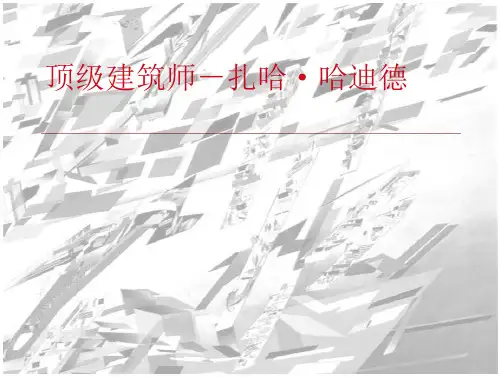
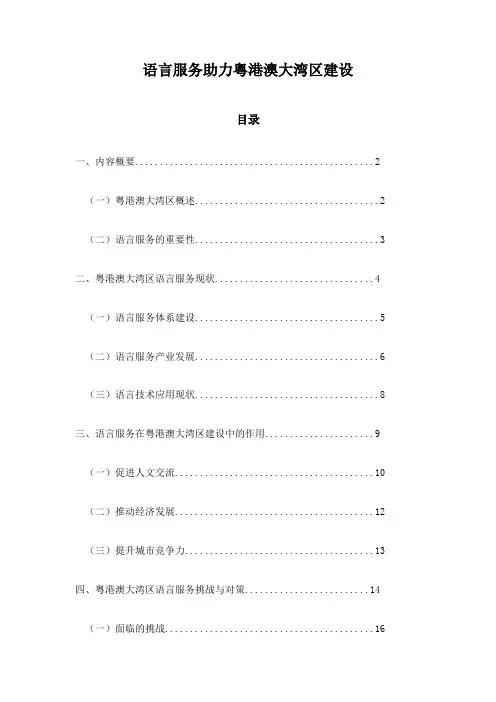
语言服务助力粤港澳大湾区建设目录一、内容概要 (2)(一)粤港澳大湾区概述 (2)(二)语言服务的重要性 (3)二、粤港澳大湾区语言服务现状 (4)(一)语言服务体系建设 (5)(二)语言服务产业发展 (6)(三)语言技术应用现状 (8)三、语言服务在粤港澳大湾区建设中的作用 (9)(一)促进人文交流 (10)(二)推动经济发展 (12)(三)提升城市竞争力 (13)四、粤港澳大湾区语言服务挑战与对策 (14)(一)面临的挑战 (16)1. 语言多样性带来的挑战 (16)2. 语言服务人才短缺问题 (17)3. 技术应用与创新的不足 (18)(二)应对策略 (19)1. 加强语言服务政策规划 (20)2. 加大语言服务人才培养力度 (22)3. 推动语言技术创新与应用 (23)五、语言服务与粤港澳大湾区的未来发展 (24)(一)语言服务与港澳融入国家战略 (26)(二)语言服务与湾区城市建设合作 (27)(三)语言服务与湾区文化交流互鉴 (28)六、结语 (29)(一)总结 (29)(二)展望未来发展趋势 (30)一、内容概要随着粤港澳大湾区建设的深入推进,语言服务在促进区域内的交流与合作、提高人才素质、推动科技创新等方面发挥着越来越重要的作用。
本文档旨在分析语言服务在大湾区建设中的关键作用,探讨如何提升语言服务质量和水平,以及政府、企业和个人应如何充分利用语言服务资源,共同推动大湾区建设取得更加丰硕的成果。
本文档将对粤港澳大湾区建设的基本情况进行概述,分析区域内的语言服务需求和市场潜力。
将重点关注语言服务的人才培养、产业发展和服务创新等方面,提出相应的政策建议和实施路径。
通过对典型案例的分析,总结语言服务在大湾区建设中的成功经验和启示,为其他地区提供借鉴和参考。
(一)粤港澳大湾区概述粤港澳大湾区,是中国经济活力最旺盛、创新能力最强的区域之一。
它涵盖了广东省的珠江三角洲地区,包括广州、深圳、珠海等多个重要城市,以及香港和澳门特别行政区。
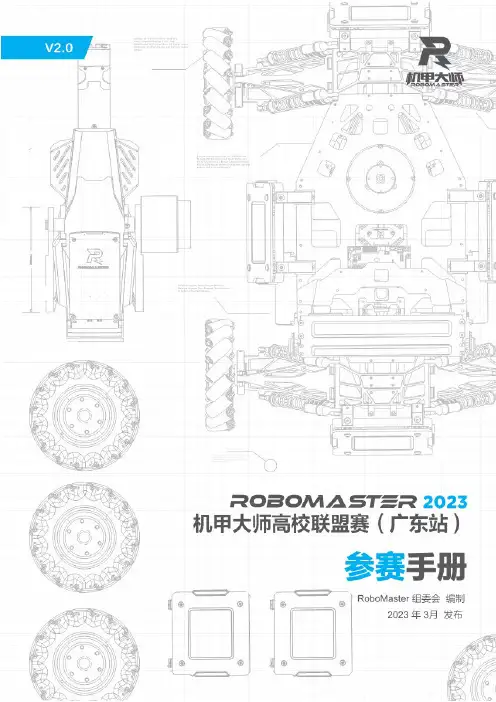
2 © 2023 大疆创新 版权所有声明参赛人员不得从事或参与任何经RoboMaster 组委会认定的涉嫌公众争端、敏感议题、冒犯大众或某些大众群体或其它破坏RoboMaster 形象的行为,否则,组委会有权永久取消违规人员的比赛资格。
阅读提示符号说明禁止重要注意事项操作、使用提示词汇解释、参考信息修改日志日期版本 修改记录 2023.04.15V2.0首次发布© 2023 大疆创新 版权所有3目录声明 ......................................................................................................................................................... 2 阅读提示 .. (2)符号说明 .......................................................................................................................................... 2 修改日志 .................................................................................................................................................. 2 1. 大赛概要 ................................................................................................................................................ 5 1.1 简介 .................................................................................................................................................. 5 参赛队伍名单 .......................................................................................................................................... 5 2. 赛制和奖项 ........................................................................................................................................... 10 2.1 大赛制度 .. (10)2.1.1 抽签方式 .............................................................................................................................. 10 2.1.2 赛制 ...................................................................................................................................... 10 2.2 奖项设置 .. (11)2.2.1 3V3对抗赛 ............................................................................................................................ 11 2.2.2 步兵对抗赛 ........................................................................................................................... 12 2.2.3 机器人实战奖 ....................................................................................................................... 12 3. 赛季日程 .............................................................................................................................................. 14 3.1 场地适应性训练时间表 ................................................................................................................... 16 3.2 比赛场序及时间表 .......................................................................................................................... 18 3.3 比赛流程 .. (26)3.3.1 报到日流程图 ....................................................................................................................... 26 3.3.2 比赛日流程图 ....................................................................................................................... 27 3.3.3 单场比赛流程图 ........................................................................................................................... 28 4. 场馆信息 .............................................................................................................................................. 29 4.1 比赛地点 ......................................................................................................................................... 29 4.2 场地示意图 . (29)4.2.1 场地位置 .............................................................................................................................. 29 4.2.2 场地规划图 ........................................................................................................................... 29 4.2.3 参赛队观赛席 ....................................................................................................................... 31 4.3 入馆声明 ......................................................................................................................................... 31 4.4 入校方案 ......................................................................................................................................... 31 4.5 主要交通路线 ................................................................................................................................. 32 4.6 餐饮安排 ......................................................................................................................................... 33 4.7 卫生间指引 ..................................................................................................................................... 35 4.8 停车位指引 . (36)5. 参赛声明 (37)5.1 参赛安全须知 (37)5.2 赛前声明 (38)5.3 知识产权声明 (39)4 © 2023 大疆创新版权所有© 2023 大疆创新 版权所有51. 大赛概要1.1 简介作为全国大学生机器人大赛旗下赛事之一,RoboMaster 机甲大师赛高校系列赛,是由大疆创新发起,专 为全球科技爱好者打造的机器人竞技与学术交流平台。
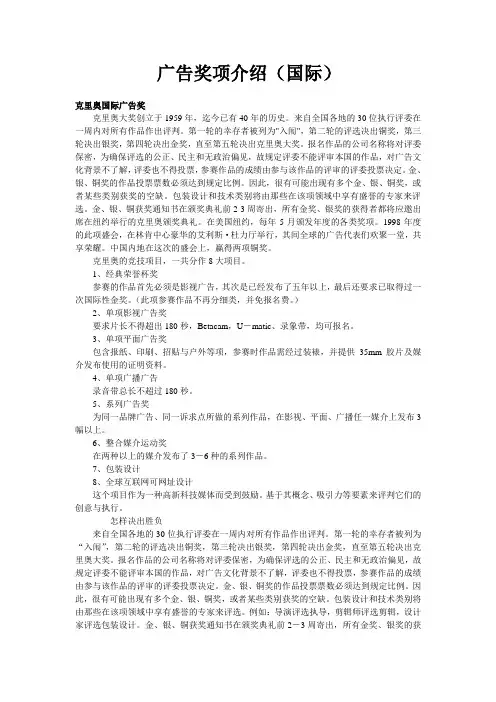
广告奖项介绍(国际)克里奥国际广告奖克里奥大奖创立于1959年,迄今已有40年的历史。
来自全国各地的30位执行评委在一周内对所有作品作出评判。
第一轮的幸存者被列为"入闱",第二轮的评选决出铜奖,第三轮决出银奖,第四轮决出金奖,直至第五轮决出克里奥大奖。
报名作品的公司名称将对评委保密,为确保评选的公正、民主和无政治偏见,故规定评委不能评审本国的作品,对广告文化背景不了解,评委也不得投票,参赛作品的成绩由参与该作品的评审的评委投票决定。
金、银、铜奖的作品投票票数必须达到规定比例。
因此,很有可能出现有多个金、银、铜奖,或者某些类别获奖的空缺。
包装设计和技术类别将由那些在该项领域中享有盛誉的专家来评选。
金、银、铜获奖通知书在颁奖典礼前2-3周寄出,所有金奖、银奖的获得者都将应邀出席在纽约举行的克里奥颁奖典礼。
在美国纽约,每年5月颁发年度的各类奖项。
1998年度的此项盛会,在林肯中心豪华的艾利斯·杜力厅举行,其间全球的广告代表们欢聚一堂,共享荣耀。
中国内地在这次的盛会上,赢得两项铜奖。
克里奥的竞技项目,一共分作8大项目。
1、经典荣誉杯奖参赛的作品首先必须是影视广告,其次是已经发布了五年以上,最后还要求已取得过一次国际性金奖。
(此项参赛作品不再分细类,并免报名费。
)2、单项影视广告奖要求片长不得超出180秒,Betacam,U-matic、录象带,均可报名。
3、单项平面广告奖包含报纸、印刷、招贴与户外等项,参赛时作品需经过装裱,并提供35mm胶片及媒介发布使用的证明资料。
4、单项广播广告录音带总长不超过180秒。
5、系列广告奖为同一品牌广告、同一诉求点所做的系列作品,在影视、平面、广播任一媒介上发布3幅以上。
6、整合媒介运动奖在两种以上的媒介发布了3-6种的系列作品。
7、包装设计8、全球互联网可网址设计这个项目作为一种高新科技媒体而受到鼓励。
基于其概念、吸引力等要素来评判它们的创意与执行。
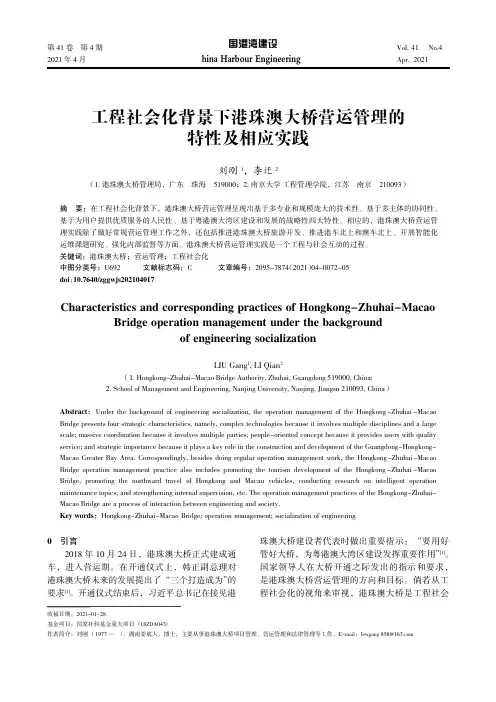
中国港湾建设Characteristics and corresponding practices of Hongkong-Zhuhai-MacaoBridge operation management under the backgroundof engineering socializationLIU Gang 1,LI Qian 2(1.Hongkong-Zhuhai-Macao Bridge Authority,Zhuhai,Guangdong 519000,China;2.School of Management and Engineering,Nanjing University,Nanjing,Jiangsu 210093,China )Abstract :Under the background of engineering socialization,the operation management of the Hongkong -Zhuhai -Macao Bridge presents four strategic characteristics,namely,complex technologies because it involves multiple disciplines and a largescale;massive coordination because it involves multiple parties;people-oriented concept because it provides users with quality service;and strategic importance because it plays a key role in the construction and development of the Guangdong-Hongkong-Macao Greater Bay Area.Correspondingly,besides doing regular operation management work,the Hongkong -Zhuhai-Macao Bridge operation management practice also includes promoting the tourism development of the Hongkong -Zhuhai -Macao Bridge,promoting the northward travel of Hongkong and Macau vehicles,conducting research on intelligent operation maintenance topics,and strengthening internal supervision,etc.The operation management practices of the Hongkong-Zhuhai-Macao Bridge are a process of interaction between engineering and society.Key words :Hongkong-Zhuhai-Macao Bridge;operation management;socialization of engineering摘要:在工程社会化背景下,港珠澳大桥营运管理呈现出基于多专业和规模庞大的技术性、基于多主体的协同性、基于为用户提供优质服务的人民性、基于粤港澳大湾区建设和发展的战略性四大特性。
tod产业园项目案例
有很多成功的TOD(Transit-Oriented Development,交通导向
型开发)产业园项目案例,下面列举几个典型的案例:
1. 马里兰市奥兰治地产项目(The Maryland City Development):该项目位于马里兰市的市中心,紧邻地铁站。
项目整合了住宅、商业和办公空间,提供了一站式工作、生活和娱乐的环境。
它通过与公共交通系统的紧密联系,鼓励居民和工作人员使用公共交通来往。
2. 新加坡圣淘沙横滨岛项目(Sentosa- Yokohama Island):这
个项目位于新加坡圣淘沙岛上,是一个综合性的旅游和娱乐开发。
项目拥有多个地铁站点和渡轮码头,方便游客前往。
整个岛上的建筑和景点都以节能环保为特色,并且有十分发达的交通系统,包括有轨电车和自行车租赁服务。
3. 中国上海虹桥商务中心项目(Shanghai Hongqiao Business Center):这个项目位于上海虹桥交通枢纽附近,是一个集商
务办公、商业零售和住宅于一体的综合开发项目。
整个项目与虹桥机场和地铁站直接相连,方便了居民和商务人士的出行。
这些案例都充分利用了交通枢纽的便利性,将不同类型的用地相结合,提供了便利的公共交通服务,从而促进了可持续发展和城市的繁荣。
19 August 2012ABU Asia-Pacific Robot Contest 2012 Hong Kong Host Organizing Committee1.One Manual Robot,one Automatic Robot and one Collector Robot are requiredfor each team.2.Manual Robot’s operator navigates Manual Robot to the T oken Stand.3.Manual Robot picks up the T oken and carries it to the Tunnel.4.Manual Robot inserts the T oken into the T oken Box of the Tunnel.5.Automatic Robot picks up the Basket in the Common Zone and puts it in anyplace of Manual Robot Zone.6.Manual Robot goes through the T unnel and picks up Collector Robot.7.Manual Robot unloads Collector Robot when the Manual Robot is in L1.A utomaticRobot carries Collector Robot across the Bridge and unloads Collector Robot inside L2 or L3.8.Manual Robot picks up the Basket and puts the Basket in the Basket Area on theIsland.9.Collector Robot can either leave Automatic Robot and climbs the stairs onto theIsland from L2,or it can be lifted up to the Island by Manual Robot from L3. 10.Collector Robot picks up the Buns in the Middle and the Lowest Layer and putthe Buns into the Basket.11.After at least one Bun from each of the two lower layers were already put intothe Basket,Collector Robot can touch Buns from the T op Layer of the Bun T ower while itself is being lifted up by Manual Robot.12.During the last one minute of the game,Manual Robot may extend its own armsto pick up Buns directly from the Lowest Layer of the Bun T ower and put them into the Basket.13.Once Collector Robot put the T op Bun into the Basket after successfully put atleast one Bun from each of the two lower layers into the Basket,the match will immediately end.This type of achievement will be called “Peng On Dai Gat”. 14.If neither team achieves the “Peng On Dai Gat” within 3 minutes,the winner shallbe decided by the total scores of the team in this match.15. A match lasts 3 minutes.History of Bun Festival 4Game Rules and Robot Design 101.Robot Set Up 112.Game Field and Objects 113.Game Procedure & Competition T asks 154.Restarting Points 185.Game Duration 206.General Restrictions 207.Deciding the Winner 228.Violations 239.Disqualification 2410.Robot Specification 2411.Importance of Safety 2612.Safety for the Robots 2613.Safety for Manual Robot Operators 2714.Domestic Contests in Each Country and Region 2715.T eams 2816.Others 28 Appendix 29-34 Figure 35-48The Tsing Ma Bridge of Hong Kong *Hong Kong is hilly with a rich landscape that includes over 200 islands,leading to a particularly strong need of bridges and tunnels.Among these we have the Cross Harbour Tunnel linking up Kowloon and Hong Kong Island across Victoria Harbour,while the Tsing Ma Bridge is the world’s longest road-and-rail suspension bridge that brings Lantau Island closer to us.T hanks to these bridges and tunnels,Hong Kong now boasts a well-developed traffic network.Peng On Bun *Banner in parade, with the Chinese words meanstimely wind and rain.Bun TowerOn Cheung Chau, one of those little islandsof Hong Kong, the Jiao-festival has beencelebrated for more than 100 years. CheungChau was once devastated by a plague in thelate Qing dynasty; accordingly local residentsset up a sacrificial altar in front of Pak T aiT emple to pray for peacefulness. Eventually,the plague ended after performing such rituals.Since then, residents on Cheung Chau haveorganised a Bun Festival every year to expresstheir thankfulness. The residents’ annualparticipation allows the ritual to pass alonggenerations.Lion dance *Meanwhile,the festival is also a platform for residents to perform their folk crafts,such as making paper-mache effigies,setting up the bamboo scaffolding of the Bun Mountain,and making handmade buns in preparation for the Bun Festival.T his is accompanied by folk performing arts like music,a parade,lion dances,qilin dances and drumming.Y ear after year,elderly residents participate in such festive activities with theiroffspring,allowing the experience to pass fromone generation to the next.And for tourists allover the world,the festival is also a carnival for thefamily,attracting tens of thousands of tourists.Asan additional note,the Cheung Chau Jiao-festivalis also listed as a State-level Intangible CulturalHeritage of China.Peng On BunThe contestants, who had already passed a priorclimbing test, secured by safety ropes, climbed ahigh tower for buns.*Float Procession in the parade * The children are acting the well-known love storyin Chinese history, the Emperor Xuanzong of TangDynasty and his concubineYang Guifei.The weeklong festival climaxes with a large,carnival-like street procession featuringcostumed children on stilts held aloft abovethe crowd, lion dances and so on. The paradewinds its way through the narrow streets,which are highlighted by the enormousbamboo towers, studded with sweet whitebuns, and where the main festivities take place.At midnight, athletes scramble up one of thetowers in a tough contest of both intellect andphysique, to grab the top-most ‘luckiest’ bunsas told in traditions so as to achieve “Peng OnDai Gat”, that means peace and prosperity. Itis from this bun-grabbing contest, an attractionfor local and foreign tourists in itself, that comesthe festival’s other name – the “Bun MountainFestival”.Traditional Chinese opera showed at the day of Bun Festival.Hong Kong will be the host city of the 11th ABU Robot Contest in 2012.By then,students from the Asia-Pacific region will gather in Hong Kong,directing robots to cross bridges and tunnels,land the island,climb the bun tower,snatch the lucky buns and achieve “Peng On Dai Gat”.Who will be the winner of the ABU Asia-Pacific Robot Contest 2012 after a great “journey” in Hong Kong? Let’s see!The night view of Victoria Harbour *1. Robot Set Up1.1 One Manual Robot,one Automatic Robot and one Collector Robot are required for eachteam.1.2 One minute is given for setting of robots before the game starts.1.3 Only the three registered members of each team,including the Manual Robot Operator,can engage in the setting up of robots.Any team that fails to complete setting of the robots within one minute can resume the setting process once the game starts.2. Game Field and Objects2.1 The field consists of an area having the dimension of 13,000mm x 13,000mm and surroundedby a wooden fence with a height of 100mm and a thickness of 50mm.The wooden fence is fixed to the field with screws.The game field is divided equally for two teams by a wooden fence with a height of 100mm and a thickness of 50mm.The competing teams are Red and Blue T eams.(Figures 1-4)2.2 The game field consists of Manual Robot Zone,Automatic Robot Zone,Starting Points,Restarting Points,Loading Areas,Common Zone and an Island.The symbols of points and areas such as A,C,M,L1,L2,L3,S1 and S2 are not necessary to be painted on the floor of the real game field.2.3 Manual Robot Zone & Automatic Robot Zone2.3.1 White lines with a width of 30mm made of matt sticker are drawn on the floor ofAutomatic Robot Zone.Each side of the square inside the white lines is 470mm.The wooden fence with a height of 100mm and a thickness of 50mm is presentedas a par tition between Manual Robot Zone and Automatic Robot Zone.(Figures 2, 3)2.4 Starting Points2.4.1 Manual Robot must start in Manual Robot Starting Point (M).2.4.2 Collector Robot is placed in Collector Robot Starting Point (C) and will be pickedup by Manual Robot.2.4.3 Automatic Robot must start in Automatic Robot Starting Point (A).(Figures 1) 2.5 Common Zone2.5.1 Common Zone has a rectangular shape with a height of 100mm,a width of 500mmand a length of 1985mm painted in yellow color.T wo notches with a depth of12mm and a diameter of 452mm are located at the surface of the Common Zone.T wo Baskets are placed in these two notches separately before the game starts.Each team can collect one Basket from the Common Zone only.(Figures 2,13) 2.6 The Basket2.6.1 The two Baskets are placed at two notches separately in the Common Zone.ABasket consists of three parts;a Basket with a diameter of 450mm and a height of400mm made of HIPS (475) sheet and plastic net or nylon net (joined by mild steelmale thread rod),a bottom base with a diameter of 450mm made of HIPS (475)sheet,a cylinder with a diameter of 80mm and a height of 388mm made of PVCTube.The weight of a Basket is 2.85kg.(Figures 8 & 11)2.7 Bun T ower2.7.1 The Bun T ower is placed on a square stage,the Island.It consists of three layers.The details of each part are explained as follows:2.7.1.1 Number of Buns in different layers:2.7.1.1.1 T op Layer:2 T op Buns (One for Blue T eam,One for Red T eam)2.7.1.1.2 Middle Layer:6 Buns (Three for Blue T eam,Three for RedT eam)2.7.1.1.3 Lowest Layer:8 Buns (Four for Blue T eam,Four for Red T eam)2.7.1.2 The weight of the Buns2.7.1.2.1 The T op Bun for the T op Layer:105gm2.7.1.2.2 The Buns for the Middle and the Lowest Layers:47gm2.7.1.3 The size of the Buns2.7.1.3.1 The T op Bun:200mm in diameter,150mm in height2.7.1.3.2 The Buns for the Middle and the Lowest Layers:150mm indiameter,100mm in height2.7.1.4 The diameter of the three layers2.7.1.4.1 T op Layer:500mm2.7.1.4.2 Middle Layer:850mm2.7.1.4.3 Lowest Layer:1200mm2.7.1.5 The height of the Bun T ower2.7.1.5.1 The T ower is 1850mm high in total (measured from the topsurface of the Island).2.7.1.5.2 The height of the three layers surface from the Island are:T op Layer:1500mmMiddle Layer:1000mmLowest Layer:500mm2.7.1.5.3 The base of the Bun T ower is 497mm high (measured from thetop surface of the Island to the bottom of the Lowest Layer).2.7.2 Positioning of the cylindrical donut shaped is fixed by centering-studs laid out in acircular fashion on each level of the conical T ower.2.7.3 The angular placement of the Buns in one layer is different with the Buns in otherlayers.(Figures 9,10)2.8 Island2.8.1 Island is a lifted up platform with a height of 400mm,a width of 3,030mm and alength of 3,050mm.It is divided equally for Red and Blue T eams.Each part consistsof a half side of Bun T ower and a notch at the corner,which presents as the BasketArea,with a depth of 12mm and a diameter of 500 mm.A Basket will be placed atthe Basket Area of the Island by Manual Robot.(Figures 2,13)2.9 Loading Areas2.9.1 Loading Area 1 (L1) is located at the floor surface of Manual Robot Zone and islocated nearby the Automatic Robot Starting Point with a length of 1,965mm anda width of 1520mm.(Figures 2)2.9.2 Loading Area 2 (L2),which is presented as the stair up to the Island,is a squareplatform with a height of 200mm and a length of 1,500mm.It is located at the sideof the Island.(Figures 13)2.9.3 Loading Area 3 (L3) is located near by the T unnel.It is a rectangular platform with aheight of 200mm,a length of 1,550mm and a width of 1000mm.(Figures 2,3,13)2.10 Tunnel & T oken Box2.10.1 A Tunnel is located at the Manual Robot Zone.The inner size of the Tunnel is2040mm in length,1200mm in width,and 1600mm at the highest point.The ceilingof the T unnel is arched.(Figures 7)2.10.2 A T oken Box is placed at the side of the T unnel.The slot of the T oken Box is 100mmin width and 400mm in length.(Figures 6)2.11 T oken2.11.1 The T oken is placed at the T oken Stand.The size of the T oken is 300mm in diameter,20mm in thickness.The weight of a T oken is 170gm.(Figure 5)2.11.2 The T oken is made of low density polystyrene with two sides of stickers covered.The graphic on two sides of the T oken surface is subject to the design of each team.In the international contest,the host organization of ABU Robocon 2012 willproduce the T oken sticker for each team.The individual contestant has to send theirsoftcopies of the T oken sticker to the host organization after the representativeteam is confirmed.Details will be provided later.2.12 T oken Stand2.12.1 The T oken Stand is fixed on the ground of Manual Robot Zone.It consists of threesections:a frame,a pole and the bottom.T he arc-shaped frame is made of mild steelwith an indent inside.2.12.2 The thickness of the frame is 40mm and the width of space inside the indent is22mm.The pole is made of mild steel with a diameter of 40mm and a height of742mm.The bottom of the T oken Stand is a round mild steel plate with a diameterof 350mm and a thickness of 3mm.(Figures 5)2.13 Bridge2.13.1 The Bridge is located in Automatic Robot Zone.It has a three-dimensionaltrapezoidal shape with a length of 3500mm and a width of 1970mm.The top of theBridge is 300mm high.(Figures 13)2.14 Obstructions2.14.1 Wooden Obstructions with a height of 100mm and a thickness of 50 mm areplaced at both Manual Robot Zone and Automatic Robot Zone.Robots have tonavigate through the zigzag path in which obstacles are presented.3. Game Procedure & Competition Tasks3.1 Manual Robot’s operator rides on Manual Robot before the game starts.3.2 Manual Robot’s operator navigates Manual Robot from Manual Robot Starting Point to theT oken Stand.3.3 Manual Robot picks up the T oken at the T oken Stand and carries it.3.4 Manual Robot’s operator navigates Manual Robot to the Tunnel.3.5 Arriving at the T unnel,Manual Robot inserts the T oken into the T oken Box.No part ofManual Robot is allowed to touch the T oken Box.Manual Robot is not allowed to start going through the T unnel before inserting a T oken into the T oken Box for the first time to cross the Tunnel.3.6 When the T oken is totally put inside the T oken Box,motion of Automatic Robot can be selfstarted or started by “one push button” by a team member after the signal from referees.Automatic Robot may start picking up the Basket in the Common Zone and puts it in any place of Manual Robot Zone.Or,Automatic Robot may start later as the strategy of the team.The task of putting the Basket in Manual Robot Zone will be considered as “Completed” when the Basket is put in Manual Robot Zone and is standing on its own on its bottom base;it means there is no contact between the Basket and neither Automatic Robot nor Manual Robot.3.7 Automatic Robot of each team is allowed to touch only one of the two Baskets in theCommon Zone and a team can only pick up the same Basket which they have touched before and if it is available.3.8 Manual Robot goes through the T unnel and proceeds to Collector Robot Starting Point. 3.9 Manual Robot picks up Collector Robot at Collector Robot Starting Point.3.10 Manual Robot carries Collector Robot and navigates through the zigzag path in whichobstacles are present.3.11 When all the contact surface of Manual Robot is totally inside the Loading Area 1,ManualRobot can unload Collector Robot.Manual Robot is allowed to extend over the space above the Automatic Robot Starting Point only during the unloading of Collector Robot.Collector Robot is not allowed to touch any part of the game field during the unloading process in L1.3.12 When Collector Robot is completely separated from Manual Robot and transferred toAutomatic Robot,motion of Automatic Robot can be self started or be started by a team member by “one push button”.There is no rule to guide the sequence for Automatic Robot to pick up the Basket and the Collector Robot.The team can pick up both items simultaneously.3.13 Automatic Robot carries Collector Robot across the Bridge towards Collector RobotLoading Area 2 or Loading Area 3.3.14 After transferring Collector Robot to Automatic Robot,Manual Robot is allowed to pick upthe Basket when it is placed in Manual Robot Zone and puts the Basket in the Basket Area on the Island.When the Basket was placed at the Basket Area,no robot is allowed to touch the Basket.3.15 Automatic Robot must unload Collector Robot inside Loading Area 2 or LoadingArea 3.Collector Robot is not allowed to touch the game field before being unloaded inside Loading Area 2 or Loading Area 3.3.16 Collector Robot can either leave Automatic Robot and climbs the stairs onto the Islandfrom Collector Robot Loading Area 2,or it can be lifted up to the Island by Manual Robot from Collector Robot Loading Area 3.3.17 The actions of Collector Robot must start-up by push-button to be pushed by AutomaticRobot / Manual Robot,or,a non-radio signal emitted by Automatic Robot or Collector Robot can automatically start itself.3.18 Collector Robot can accept the command from Manual Robot when Manual Robot picks upCollector Robot and is in physical contact with Collector Robot.While in physical contact, Manual Robot is allowed to communicate with Collector Robot by non-RF communication methods.3.19 Buns in the Middle and the Lowest Layer can be picked up and put into the Basket byCollector Robot itself while it is not in touch with Manual Robot and stands on the Island by itself.Buns will be considered as “Collected” only when they were picked up and clearly put into the Basket.Buns dropped on the game field can not be used again.3.20 A team’s Collector Robot can only pick up Buns placed on its side of the T ower.Invadingonto the opponent’s side of the T ower and the space above is not allowed,which will be a Violation.3.21 Manual Robot can directly pick up Buns from the Lowest Layer of the T ower during the lastone minute of the game,therefore 2 minutes from the start.It is not allowed to pick up Buns from the upper two layers.3.22 After at least one Bun from each of the Middle and Lowest Layers were picked up and putinto the Basket,the Bun at the T op Layer can be touched and picked up by Collector Robot while Collector Robot is being lifted up from the surface of the Island by Manual Robot. 3.23 Buns will only be counted when they are put into the Basket of the team.3.24 Once Collector Robot puts the T op Bun into the Basket after successfully put at least oneBun from each of the two lower layers into the Basket,the match will immediately end.This is called “Peng On Dai Gat”.If neither team achieves the “Peng On Dai Gat” within 3 minutes,the winner will be decided by the total scores of the team in this match.4. Restarting Points4.1 In the case of mechanical problem,or failing of a task,the robot can be brought back to itsRestarting Point to restart with the consent of referees.Restarting Points will be set up as follows:4.2 Manual Robot Starting Point (M)(after Manual Robot has left Manual Robot Starting Point (M)) -4.2.1 If the T oken was not successfully put inside the T oken Box,Manual Robot has torestart from Manual Robot Starting Point M and the T oken will be put back to thestand.4.2.2 Robot has to use Point M until it has completely entered S1.4.3 Manual Robot Restarting Point S1(after Manual Robot has gone through the T unnel successfully) -4.3.1 If Manual Robot failed to transfer Collector Robot to Automatic Robot,ManualRobot must restart at the Restarting Point S1,and Collector Robot must be putback in Collector Robot Starting Point (C).4.3.2 If Manual Robot failed to pick up the Basket or failed to put it in the Basket Area onthe Island,Manual Robot must restart from Restarting Point S1.The Basket will beput back in the place where Automatic Robot has put it in Manual Robot Zone. 4.4 Automatic Robot Starting Point (A)(after Automatic Robot has left Automatic Robot Starting Point) -4.4.1 If Automatic Robot failed to pick up the Basket in the Common Zone or failedto put the Basket in Manual Robot Zone,Automatic Robot must restart fromAutomatic Robot Starting Point (A) and the Basket will be put back to where it wasin the Common Zone.4.4.2 If the Basket is indeterminate to be grabbed by any team and the two robotsare standing still (such as the case when both team’s Automatic Robot trying tograb the same Basket at the same time),a “Compulsory Retry” for two AutomaticRobots of two teams is needed.The two Automatic Robots have to restart atAutomatic Robot Starting Point (A) after the signal from referees.“CompulsoryRetry” is commanded by a referee and both teams should follow the instruction.4.4.3 If Automatic Robot successfully completed the task of putting the Basket in ManualRobot Zone but it failed to go back to Automatic Robot Starting Point (A) toreceive the Collector Robot,Automatic Robot can be brought back to AutomaticRobot Starting Point (A) to restart after the consent of referees.4.4.4 Once Automatic Robot carried Collector Robot which was successfully detachedfrom Manual Robot and if a retry is needed,Automatic Robot can restart fromAutomatic Robot Starting Point (A) with the Collector Robot.4.5 Restarting Point S2(after Automatic Robot has crossed the Bridge successfully) -4.5.1 If Collector Robot failed to climb up the stairs onto the Island by itself at LoadingArea 2,or Automatic Robot failed to carry Collector Robot to Loading Area 3,orManual Robot is unable to pick up Collector Robot in Loading Area 3,AutomaticRobot and Collector Robot must restart together at S2.4.6 Collector Robot Loading Area 24.6.1 If Collector Robot is unloaded in Loading Area 2 and it successfully stands on theIsland and if a retry is needed,it can restart from Loading Area 2.4.7 Collector Robot Loading Area 34.7.1 If Collector Robot has been unloaded in Loading Area 3 and a retry is neededafterwards,Collector Robot will be placed in Loading Area 3 and Manual Robot hasto restart from Manual Robot Starting Point (M).5. Game Duration5.1 Each match lasts three minutes at most.5.2 In any of the following cases,the match ends immediately (even before three minutes).5.2.1 When “Peng On Dai Gat” is achieved.5.2.2 Disqualification is announced in the knockout.5.2.3 When the referee judges that the game can not continue.6. General Restrictions6.1 Substitution of Manual Robot’s Operator is not allowed in a single match.6.2 Manual Robot’s Operator can not touch the T oken,Collector Robot,Automatic Robot,Basket or any other parts of the game field after the game has started.The feet of the operator can not touch any surface of the game field as well.6.3 Manual Robot is not allowed to move beyond the fence and to touch the floor of AutomaticRobot Zone.However,part of Manual Robot can extend over the space above Automatic Robot Starting Point (A),the Loading Area 3 and the space above the Island.6.4 None of the robot is allowed to touch any parts of the T oken Box.6.5 Automatic Robot of each team is only allowed to touch one of the two Baskets and it canonly pick up the same Basket which it has touched and if this Basket is available.6.6 After being picked up by Manual Robot at Collector Robot Starting Point (C),CollectorRobot cannot touch any part of the game field until it is unloaded in Collector Robot Loading Area 2 or Loading Area 3.6.7 After starting the Automatic Robot,the team members who perform the starting actionmust leave the game field immediately.6.8 Automatic Robot can not extend over the space above all the area of opponent team.6.9 Automatic Robot is not allowed to touch the game field in Loading Area 1, LoadingArea 2,Loading Area 3,Manual Robot Zone,Common Zone and the Island.6.10 Automatic Robot is not allowed to extend itself into the space above Loading Area 1,Loading Area 2,Loading Area 3,the Island,Common Zone and Manual Robot Zone.Automatic Robot is allowed to extend over the space above Common Zone and Manual Robot Zone only when picking the Basket from Common Zone and placing the Basket in Manual Robot Zone.6.11 Manual Robot should not use any part of the T ower as mechanical support.Manual Robotmay momentarily touch the Lowest Layer of the Bun T ower during picking up the Buns,but not the T op Layer and the Middle Layer.6.12 When Manual Robot is lifting up Collector Robot,all parts of Collector Robot must nottouch the Island.6.13 The Buns at the T op Layer cannot be touched unless at least one Bun from the Middle andthe Lowest layers have already picked up and put into the Basket.6.14 Manual Robot Operator cannot directly drive any mechanical motions.All the actions of therobots must be driven by robotic means.6.15 A team’s robots can only pick up Buns placed on its side of the T ower.It is not allowed toinvade onto the opponent’s side of the T ower and the space above.6.16 Robots are not allowed to reach or to enter their respective restricted areas.6.17 Manual Robot can communicate with Collector Robot when they are in physical contact.6.18 Automatic Robot can communicate with Collector Robot by non-radio signal.ManualRobot is allowed to switch on the Collector Robot while they are in physical contact.6.19 Communication between Manual Robot and Automatic Robot is not allowed.ManualRobot cannot communicate with Automatic Robot via Collector Robot.6.20 Communications with any robot in the game field is not allowed except mentioned in 6.17and 6.18.7. Deciding the Winner7.1 “Peng On Dai Gat”7.1.1 First,the team picks up at least one Bun from each of the Middle Layer and theLowest Layer and put them into the Basket.Secondly,the team picks up the Bunin the T op Layer and put it in the Basket.It will achieve ‘Peng On Dai Gat’and thematch ends immediately.7.1.2 The achievement of “Peng On Dai Gat” will lead to victory directly.7.1.3 If the two teams achieve “Peng On Dai Gat” at the same time,the winner shall bedecided by the total scores after deduction of Violations points in that match.7.1.4 If the two teams achieve “Peng On Dai Gat” at the same time with the same earningscores,the winner shall be decided by time record of the first Bun being put into theBasket.7.2 If neither team achieves the “Peng On Dai Gat” within 3 minutes,the winner shall bedecided by the total score after deduction of Violation points in that match.The team that earns higher score is the winner.The score of each task is described as follows:7.2.1 Manual Robot slots the T oken in the T oken Box.[10 scores]7.2.2 Automatic Robot puts the Basket in Manual Robot Zone.[20 scores]7.2.3 Manual Robot puts Collector Robot on Automatic Robot.[10 scores]7.2.4 Automatic Robot unloads Collector Robot either in Loading Area 2 or LoadingArea 3.[30 scores]7.2.5 Manual Robot puts the Basket in the Basket Area on the Island.[10 scores]7.2.6 Buns in the Lowest Layer are collected.[10 scores per Bun]7.2.7 Buns in the Middle Layer are collected.[25 scores per Bun]7.2.8 The Bun in the T op Layer is collected.[Peng On Dai Gat,game ends]7.3 If the two teams have the same final scores,the winner is determined by the time record ofthe first Bun being put into the Basket.7.4 If both teams could not put any Bun in the Baskets and finished with the same scores,theteam with the best time record of inserting the T oken into the T oken Box will be the winner.7.5 If both teams can not insert the T oken into the T oken Box,the winner will be decided by theJudges.7.6 If teams in the same group during group match have the same number of “Peng On DaiGat”,the team with the best time record of “Peng On Dai Gat” (with the fastest completion time of the whole game) will be the winner.In the knockout,it will be regulated by 7.1-7.5.8. Violations8.1 The team with five Violations in a match will be disqualified.Negative scores may appear insome cases.8.2 When the Violation occurs,the team will be deducted 10 points and the team has to bringthe violating robot back to the point which the referee indicates.The Violations are categorized as follows:8.2.1 Any parts of any robot or objects held by a robot enter the opposing teamAutomatic Robot Zone or the space above it.8.2.2 Any part of any robot or the object held by a robot cause obstruction or difficultyto the opposing team.8.2.3 Any Basket is pushed down onto the opposing team area.8.2.4 Any parts of any robots enter their respective restricted areas.8.2.5 The Bun at the T op Layer is picked up before at least one Bun from the Middle andthe Lowest Layers were picked up and put them into the Basket.8.2.6 Any parts of robots enter the opposing team Automatic Robot Zone and physicallytouch the robots or Buns of the opposing team,except in the Common Zone.8.2.7 Other actions that infringe on the rules without mentioning in the Disqualificationare considered as Violations.。
深圳湾“超级城市”国际竞赛文件Competition File for Shenzhen Bay “Super City”International Competition城市:中国,深圳基地:深圳湾超级总部核心区规划用地面积:35.2公顷规划建筑面积:150-170万平米竞赛内容:城市设计及建筑设计Location: Shenzhen, China,Site: Core areas of Shenzhen Bay Super headquartersPlanning land use area: 35.2 hectaresPlanning Building area: 1500-1700 thousand square metersContent: Urban and Architectural Design一、区位背景Project background深圳位于中国广东省南端,与香港隔河相望。
2012年常住人口1054万,GDP 12950亿元,连续多年在中国大陆城市中保持第四。
在三十多年的时间内,从中国南海之滨的小城镇,发展成为现代化大都市,深圳是中国改革开放和现代化建设的精彩缩影。
Shenzhen is located in the South of Guangdong Province opposite Hong Kong. In 2012, the permanent population is 10.54 millions, and GDP is 1295 billion, ranking the fourth among all the mainland cities in China for many years. In the past 30 years, Shenzhen has developed from a small coastal town to a modern metropolis, and became the symbol of Chinese reform and opening up and modernization construction.根据最新深圳市城市总体规划,环深圳湾地区将成为深港都市圈最重要的城市地区,成为激发深圳跻身全球一流城市的能量起点,由西至东布局了前海深港现代服务业合作区、后海商务区和深圳湾超级总部基地。